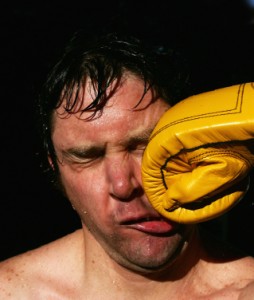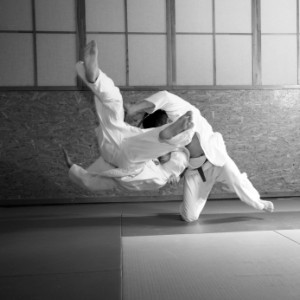In my teacher’s and my own dōjō (道場 – “martial arts training hall”) we spend a lot of time cultivating our skills as uke. An uke (受け) is a martial arts student who, during a given training session, “receives” a technique from another student acting as the tori (取り). Wikipedia defines the difference as one “who completes a successful technique [tori] rather than who initiates one [uke].” Having a good uke as a training partner is very important, but being a good uke is paramount.
The role of uke often gets a bad rap. Too many times I have seen students relegate themselves to becoming little more than an “I attack, then stand around while the other guy does something to me” participant. When it’s time to be uke, the “pause” button gets pressed and human punching bags are born. That doesn’t seem right, does it?
It certainly doesn’t feel right, at least not to me.
Here’s the reality check: if 50% of your training time is spent as an uke, which I hope all of you do, but 100% of your focus and concentration during your training occurs only when you are the tori, that means you spend half of every training session doing absolutely no training at all – 0%! Does that make sense? Or, perhaps it’s better to ask, “should that make sense?” The 10 years of training you are so eager to talk about during parties and social gatherings is realistically closer to five years of actual time. Humbling, isn’t it?
Practice does not make perfect. Only perfect practice makes perfect.
— Vince Lombardi
With a small change in your approach to the responsibility of being a good uke, you can double the effectiveness of your training without doubling the amount of time you actually train. Here are some suggestions on how you can do it:
Engage and Communicate
First and foremost, be an active and willing participant. Engage and work with your tori in a way that provides direct feedback on several levels – physical, mental, and spiritual. You should be working together and helping each other, so let your tori know exactly and specifically what he is doing wrong and what he’s doing right. Even small hints go a long way towards perfecting a technique. But don’t over communicate; say just enough to help him figure it out on his own.
Move With Clarity
My teacher often stops us in the middle of a technique and asks if we are aware of what certain body parts are doing. It keeps us on our toes (pun intended) and gives us the reality check we need to see if our taijutsu (体術 – “body movement”) requires more clarity and better integration. For example:
- Are your hips open?
- Are your knees bent?
- Are your knees over your toes?
- Are your toes spread apart and gripping the ground?
- Are your feet pronated or supinated?
- What is your right hand doing?
- Where is your left foot pointed?
- Is your back straight?
- Is your neck craned forward or properly aligned with your spine?
- When you are finished punching or kicking, are you leaning forward so far that you can’t left your front leg?
- Is your punching arm locked or slightly bent?
- Are you supporting your arm with your bicep and triceps or your shoulder and lat?
- Are you supporting your leg with your hamstring and quads or your hips and spine?
Take this opportunity – take every opportunity – to clarify the biomechanics of your movement.
Realistic Attacks
 “You fight the way you train” is a popular saying in our dōjō. Put another way, “You protect yourself and others the way you train.” Punching six inches too far away from your tori is not effective. It’s a great safety measure to avoid lawsuits from overly-protective parents, but it’s not realistic. When you punch or kick at your tori, do so in such a way that he will get hit if he doesn’t move. Don’t knock him out, of course, but “remind” him just hard enough that he didn’t move in the right direction or with the correct speed and timing. It not only helps your tori to respond accordingly but also trains you to use the proper distance. Be focused and punch with reduced power while maintaining the same intensity and intention as you would when punching at full strength. You can have 100% intensity without 100% speed and power; you don’t want to hurt anyone during training.
“You fight the way you train” is a popular saying in our dōjō. Put another way, “You protect yourself and others the way you train.” Punching six inches too far away from your tori is not effective. It’s a great safety measure to avoid lawsuits from overly-protective parents, but it’s not realistic. When you punch or kick at your tori, do so in such a way that he will get hit if he doesn’t move. Don’t knock him out, of course, but “remind” him just hard enough that he didn’t move in the right direction or with the correct speed and timing. It not only helps your tori to respond accordingly but also trains you to use the proper distance. Be focused and punch with reduced power while maintaining the same intensity and intention as you would when punching at full strength. You can have 100% intensity without 100% speed and power; you don’t want to hurt anyone during training.
Use Active Resistance
Present enough of a puzzle so your tori has to work to solve it. Just enough resistance, just enough force, just enough of a challenge. If he’s trying to apply a technique but not quite getting it, coach him through the correct movement while maintaining active resistance so he can feel how it works. Once he starts to “get it,” change the angle and direction slightly so it doesn’t become a rote exercise.
Be Willing to Get Hit, Locked Up, and Thrown Down
Let’s face it, not many people enjoy being hit. But we are studying “martial” arts, after all, so a degree of combativeness is ever present and should not be removed from your training. It is important to know what it feels like to be hit, locked, and thrown; you need to know that when you get punched you will survive and you can continue to protect yourself and others during an attack. Your tori also needs to understand what it takes to punch, lock up, and throw someone.
When you do get hit, locked, or thrown, approximate what your natural reaction might be and let your body be moved so flow is maintained throughout the technique’s execution.
Be Considerate of Skill Level
When training with new students you must accept that they don’t know as much as you do. Be mindful to not force-feed 800 things for them to remember every time they do a technique. New students should be allowed to get away with bad habits more so than seasoned budōka (武道家 – “martial artists”). (Seasoned budōka should not be allowed to get away with any.) Also take the opportunity to double-check and make sure you’re not guilty of the same mistakes you are trying to correct! If you are training with someone of similar skill, work in detail on the finer points and see if you can solve the puzzle together. If your tori is of higher rank, listen to what is being said to you and watch what they are doing.
Protect Yourself and Your Partners From Injury
It’s all about ukemi (受身 – “injury prevention”). Ukemi is not just rolling, flips, and cartwheels. Ukemi is also knowing how to protect your joints from injury when locked, being aware of where you’re going when you roll, are thrown, or fall, and also knowing when to not be thrown. If you get hurt you cannot train effectively, right? Be mindful of the dynamic between you and your tori and protect yourself at all times. Not overly-protective to the point of being impossible to work with, but protected and safe so you can continue to train.
Your ability to protect yourself also directly correlates to your ability to keep your tori safe. If you are not confident in your ukemi then there is a chance that you might respond in a way that ends up injuring your training partner. In the “real world” this also directly correlates to your ability to keep your attacker safe. Protecting self and others; all others, if possible.
Ukemi! Ukemi! Ukemi!
So Be a Good Uke, Won’t Ya?
In case you didn’t get the gist by now, being an uke is about your training just as much as it is your partner’s training. You might find that training as an uke, when done right, is actually much more challenging than training as a tori. Not only will you become a better martial artist, but your buyū (武友 – “martial arts friends”) will most assuredly become better, too. When you work together to cultivate a feeling of cooperation, support, encouragement, and hard work, that feeling spreads within your entire organization and the potential for progress grows exponentially. That is what training is all about, and it could all start with you working to become a better uke.
Ganbatte (頑張って – “Keep Going!”)






2 Comments
Ron Forzani
August 19, 2011Memorable essay. This reminds us (Tori and Uke)that we are not in a contest and that our goals while training should be of mutual benefit. Josh has the knack of clearly explaining his warrior philosophy, and providing clear training instructions in the dojo. I am inspired by these words, and therefor pledge to be more aware and considerate of my Uke.
Hiit
August 24, 2011Great post I like the photo:), thank you for publishing it. Love your site
Leave A Response